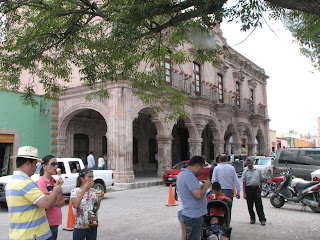We learned that the tours are meant to support the local economy. We drove through the green beautiful mountains and our first stop was a few miles out of Guanajuato at a town called Santa Rosa which is known for its preserves and candy We weren't the only van that arrived at the same time and the roads and the store was packed with others apparently on the same tour as us. Some of our group hadn't had breakfast and went to find something to eat while the rest of us entered the shop.
| They lecture about their products. Our group stood at the rear and other groups after us stood at the side of the room. |
 |
After waiting 15 or 20 minutes for those to return from their breakfast, we drove to our next stop. This town was Dolores Hidalgo which is a composite name. The city was first known as Dolores after the Virgin Dolores but Father Miguel Hidalgo uttered his famous cry for freedom in 1810 and once Mexico gained its indepence, Hidalgo was attached to the name,
But our first stop had nothing to do with independence. It had to do with music. We stopped at the cemetery where Jose Alfredo Jimenez was buried. He was the great Mexican singer and song writer who died in 1973 at age 47. He died young due to over use of alcohol. He composed over 1000 songs that the mariachis still sing and are part of Mexico's music heritage. .
The tomb for Jose Alfredo Jimenez is a 3 foot high and 30 long cement serpentine serape [scarf] in bright striped colors with the names of many the songs he wrote written on the stripes. The serape lead to a sombrero leaning on its edge that had to be 15 feet in diameter and 8 feet high. It was incredible and the rest of the panteon was nicely kept and all white sepulchers.
Delores Hidalgo is another city whose name has been compounded. It was once named Delores for a virgin saint and Hidalgo was added in honor of Miguel Hidalgo who was born here. He was born in Mexico but his parents were both from Spain so he was a "criollo" and an unorthodox priest who was concerned about his poorest parishioners and helping them to be self-sufficient. We walked through a house where he lived with a huge warehouse where accepted and stored the tithing donations from his parish.
He was invited to be part of a conspiracy who wanted to overthrow the Spanish rule in Mexico. When the conspiracy was discovered, the group wondered if to give up their plan or take up arms, they charged Hidalgo with making the decision. In answer, in the early hours of Sunday, September 16, 1810, he rang the church bells and encouraged his parishoners to take up arms and fight. This event is known as "El grito" (The Cry) and is still celebrated year after year. Because he was a priest, he attracted the poor who followed him with picks and shovels. Things grew and at one time he was leading 80,000 people before he was captured and killed.
The Spaniards who came to Mexico were rich and wanted to live in style even in Mexico.
We walked around the city park in Dolores Hidalgo for 1/2 hour before driving to Atotonilco.
A large parish church in Atotonilco is a Word Heritage Site noted for its artwork. Also the banner depicting the Virgin of Guadalupe was taken from here and used as Hidalgo's flag when the war for Mexico's Independence began.
As we were leaving the parish, we heard the music and saw the group of people coming to the parish for some local celebration.
We drove to the outskirts of San Miguel de Allende and ate at a local restaurant before going once again to the historical center where we were given an hour to walk around before our 1 1/2 bus ride back to Guanajuato.
We noticed a real estate sign showing the prices of living here and they are very comparable to prices we would find in Utah. The cost of the food and local help is a lot less but we won't retire here even though they do have a golf course..


























No comments:
Post a Comment